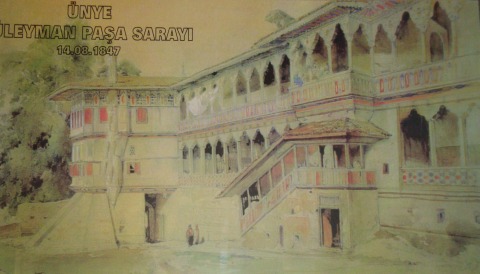The ghost of Süleyman’s Palace Population: 97,500
Right on the Black Sea Highway as it tears along the coast from Samsun to Rize, Ünye is the sort of town it would be easy to whip through without discovering what it has to offer. Brief stoppers will glimpse the seashore with a couple of inviting teahouses and the big main square with dancing fountains leaping from the pavement. But if you stop the night here you’ll discover that Ünye has quite a lot more to offer.
This is a town which is dominated by the ghost of a lost treasure. Standing in the main square you will see a length of wall which it would be easy to assume was at least as old as the castle. Instead it turns out to have been part of the outer wall of the garden that used to surround the extraordinary Süleyman Paşa Sarayı (Palace of Süleyman Paşa), an early 19th-century provincial governor who lived in a home of almost Mughalesque magnificence right on what was then the seafront. Like so many partially wooden Black Sea buildings, the palace fell victim to a fire in 1852/3. It lives on in a drawing by Jules Laurens made in 1847 and in the name of the nearby Saray Cami (1716) which was probably where the household staff prayed.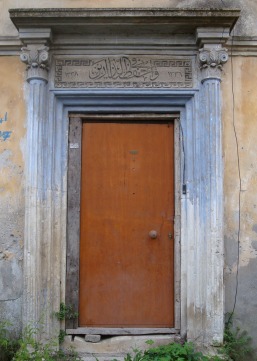
Around town
Ünye may look entirely modern but some fine Ottoman mansions still live on around the Sebile Hanım Konağı and most impressively in Kadılar Yokuşu (Judge’s Hill), a steep cobbled street that rises up behind the Eski Hamamı (Old Turkish Bath). It was here that the judges (kadıs) of 19th-century Ünye used to live in some style in spacious wood-and-stone houses with ostentatiously decorated gateways and gardens adorned with palm trees and other luxuriant greenery.
Today their houses are either empty or occupied by people whose circumstances are a world away from those of the original owners. The same is also true a few streets away where a more conventional 18th-century Ottoman-style wooden house has been converted into a Yaşayan Kültur Miras Müzesi (Living Cultural Heritage Museum).
The heart of modern Ünye is Cumhuriyet Meydanı (Republic Square) with its predictable statue of Atatürk. In one corner a plane tree believed to date back some 500 years provides a focal point for local gatherings. Facing it across the square is the Eski Hamamı, the only one of the town’s three bathhouses that is still open for business (the remains of the others lurk like battered spaceships amid the apartment blocks). From the outside it may not be especially impressive but inside a labyrinth of bathing areas provides a great place to unwind, with a wash and massage costing a fraction of the prices charged in İstanbul’s better known bathhouses.
A few old stone buildings still survive in the back streets especially around pretty little Dönerçeşme Meydanı (Revolving Fountain Square); one of them houses the friendly Sofra restaurant which serves excellent food including a very tasty chocolate souffle.
In the back streets you may stumble upon the late 19th-century Greek Orthodox Meryemana Panagi (Yalı) Kilise (Church of the Virgin Mary). In 2024 it was in the process of being restored and turned into a cultural centre.
Across the road from the main square a tea garden lurks in a small park filled with soaring pine trees. The park is named after the medieval poet-saint Yunus Emre whose tomb is signposted off the road leading to the castle. This is something of a mystery given that another tomb of Yunus Emre can be seen in the village named after him near Sivrihisar in Central Anatolia but it turns out that Turkey has nine different places laying claim to his remains. The tomb near Sivrihisar is considerably more beautiful than the one near Ünye; only die-hard fans of the poet need worry about side-tracking to see it.
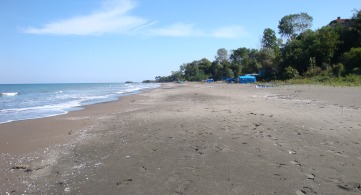 West of Yunus Emre Park lie Ünye’s inviting bays and beaches. The finest stretch of sand is at Uzunkum (Long Beach), still within the town boundaries and backed by a line-up of small hotels and pensions – – it’s said to be the longest stretch of sand along the Black Sea.
West of Yunus Emre Park lie Ünye’s inviting bays and beaches. The finest stretch of sand is at Uzunkum (Long Beach), still within the town boundaries and backed by a line-up of small hotels and pensions – – it’s said to be the longest stretch of sand along the Black Sea.
As you make your way out there you might want to divert down to the water just past the Çamlık pine grove to inspect a rocky promontory on which there was once a church dedicated to St Nicholas.
Before you leave, grab a bird’s eye view of Ünye from Çakırtepe (Goshawk Hill), a hill at the back of town with a wonderful restaurant lined up to scoop the view back out to sea.
With your own wheels you might want to make a quick excursion along the road leading to the local cement factory, then on to a small roadside fountain where a right turn leads to a dead end in front of a large orange-painted house. From here a path winds up through an apple orchard to an arched niche in the rockface known as the Tozkoparan Mezarı (tomb). Information about it is sadly lacking but if the tomb beneath Ünye Castle dates back to Pontic times the likelihood must surely be that this one does to.
Ünye (Çaleoğlu) Kalesi (Ünye Castle)
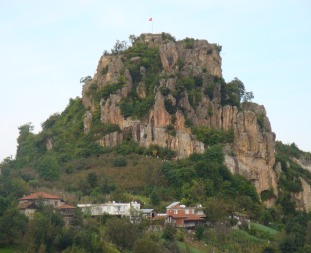 Ünye Kalesi is an extraordinary eyrie-like castle that seems designed to defy its visitors’ sense of what is possible. From this lofty stronghold it would have been possible for even the most lackadasical of guards to spot an enemy as they saddled up to ride out from Samsun. Today only the most foolhardy actually climb to the top of Ünye Kalesi; the view is quite breath-taking enough from its lower reaches without risking one’s neck on the treacherous path. In any case, there’s not a great deal to see inside the fortifications since only pieces of wall survive.
Ünye Kalesi is an extraordinary eyrie-like castle that seems designed to defy its visitors’ sense of what is possible. From this lofty stronghold it would have been possible for even the most lackadasical of guards to spot an enemy as they saddled up to ride out from Samsun. Today only the most foolhardy actually climb to the top of Ünye Kalesi; the view is quite breath-taking enough from its lower reaches without risking one’s neck on the treacherous path. In any case, there’s not a great deal to see inside the fortifications since only pieces of wall survive.
Nor is a great deal known about the site. An impressive-looking rock-cut tomb overlooking the car park probably dates back to the period (291–63 BC) when the Pontic kings ruled the area from their capital in Amasya but the stretch of wall that has been restored to serve as an entrance looks as if it would have been built some time in the Middle Ages. More tombs were exposed during restoration in 2009. In 2018 plans to make the castle accessible to tourists were announced.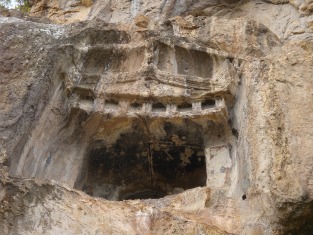
Sleeping
A bypass should by now have returned some peace to the town centre which had been blighted by noise from the Black Sea Highway.
Hotel Grand Kuşçalı On the main road facing the sea, this hotel offers plain but serviceable rooms. Tel: 0452-324 5200
Transport info
The intercity otogar is on the eastern outskirts of town. There are frequent minibuses to Ünye from Samsun and Ordu. It’s easy to hire a taxi to take you to Ünye Kalesi and the Tozkoparan tomb in the same trip.
Day trip destinations
Yason Burnu (Jason’s Headland)
